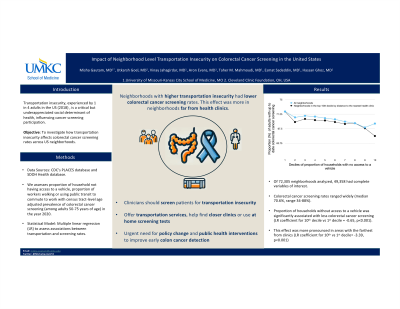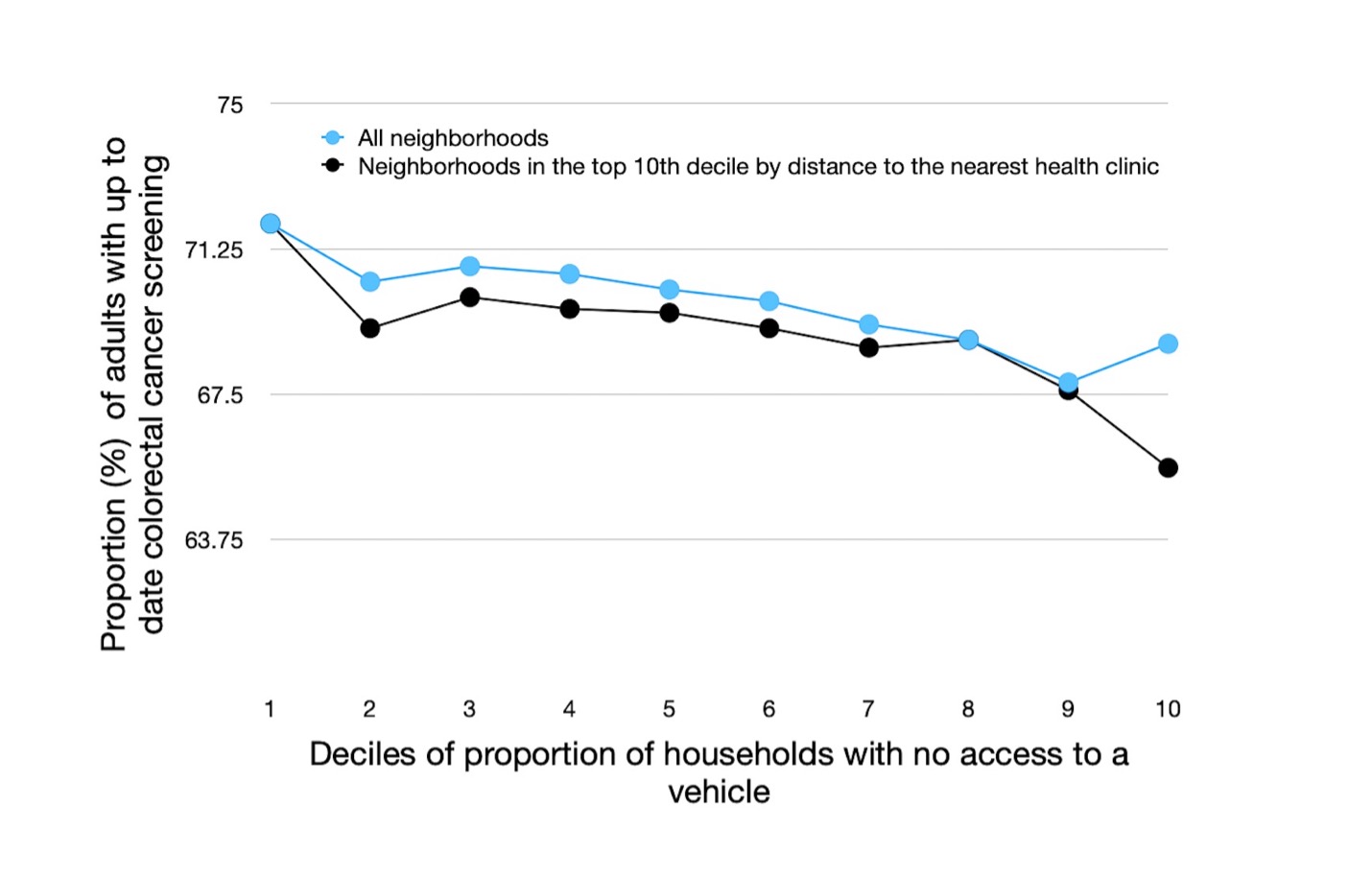Tuesday Poster Session
Category: Colorectal Cancer Prevention
P3828 - Impact of Neighborhood-Level Transportation Insecurity on Colorectal Cancer Screening in the United States
Tuesday, October 29, 2024
10:30 AM - 4:00 PM ET
Location: Exhibit Hall E

Has Audio

Misha Gautam, MD
University of Missouri - Kansas City School of Medicine
Kansas City, MO
Presenting Author(s)
Award: Presidential Poster Award
Misha Gautam, MD1, Utkarsh Goel, MD2, Vinay Jahagirdar, MD1, Evans Aron, MD1, Tahar M. Mahmoudi, MD1, Esmat Sadeddin, MD1, Hassan Ghoz, MD1
1University of Missouri - Kansas City School of Medicine, Kansas City, MO; 2Cleveland Clinic Foundation, Cleveland, OH
Introduction: One in four adults in the US experienced some form of transportation insecurity in 2018. Inadequate access to reliable transportation is an underappreciated social determinant of health (SDOH) and can have implications on individual and population level health outcomes
Methods: We linked the Centers for Disease Control and prevention (CDC)’s PLACES database with the Agency for Healthcare Research and Quality’s SDOH Health database. We then assessed the proportion of households not having access to a vehicle, proportion of workers using public transit to commute to work, and proportion of workers having to walk to commute to work (not using personal, public, or other forms of transport) on Census tract-level age adjusted prevalence of colorectal cancer screening among adults 50-75 years of age in the year 2020 using multiple linear regression (LR)
Results: Of the 72,305 neighborhoods included in PLACES, 49,358 neighborhoods with complete variables of interest comprised our study cohort. Prevalence of up-to-date colorectal cancer screening was highly variable across neighborhoods (median 70.6%, range 34-88%). After accounting for median household income and neighborhood population, the proportion of households without access to a vehicle was significantly associated with decreased colorectal cancer screening (LR coefficient for 10th decile vs 1st decile = -0.65, p< 0.001). Areas with the greatest distance to the nearest health clinic experienced a greater detrimental effect of vehicle unavailability on colorectal cancer screening (LR coefficient for 10th vs 1st decile= -3.39, p< 0.001, Figure 1). Similar trends were seen with proportion of workers having to walk to commute to work.
Discussion: Higher transportation insecurity in US neighborhoods was significantly associated with lower rates of colorectal cancer screening, especially in areas lacking local proximity to their nearest health clinics. These findings encourage policy efforts to increase physical proximity to healthcare access in US neighborhoods and highlight the possible role of screening for transportation insecurity during primary care delivery to improve the rates of age-appropriate cancer screening.

Disclosures:
Misha Gautam, MD1, Utkarsh Goel, MD2, Vinay Jahagirdar, MD1, Evans Aron, MD1, Tahar M. Mahmoudi, MD1, Esmat Sadeddin, MD1, Hassan Ghoz, MD1. P3828 - Impact of Neighborhood-Level Transportation Insecurity on Colorectal Cancer Screening in the United States, ACG 2024 Annual Scientific Meeting Abstracts. Philadelphia, PA: American College of Gastroenterology.
Misha Gautam, MD1, Utkarsh Goel, MD2, Vinay Jahagirdar, MD1, Evans Aron, MD1, Tahar M. Mahmoudi, MD1, Esmat Sadeddin, MD1, Hassan Ghoz, MD1
1University of Missouri - Kansas City School of Medicine, Kansas City, MO; 2Cleveland Clinic Foundation, Cleveland, OH
Introduction: One in four adults in the US experienced some form of transportation insecurity in 2018. Inadequate access to reliable transportation is an underappreciated social determinant of health (SDOH) and can have implications on individual and population level health outcomes
Methods: We linked the Centers for Disease Control and prevention (CDC)’s PLACES database with the Agency for Healthcare Research and Quality’s SDOH Health database. We then assessed the proportion of households not having access to a vehicle, proportion of workers using public transit to commute to work, and proportion of workers having to walk to commute to work (not using personal, public, or other forms of transport) on Census tract-level age adjusted prevalence of colorectal cancer screening among adults 50-75 years of age in the year 2020 using multiple linear regression (LR)
Results: Of the 72,305 neighborhoods included in PLACES, 49,358 neighborhoods with complete variables of interest comprised our study cohort. Prevalence of up-to-date colorectal cancer screening was highly variable across neighborhoods (median 70.6%, range 34-88%). After accounting for median household income and neighborhood population, the proportion of households without access to a vehicle was significantly associated with decreased colorectal cancer screening (LR coefficient for 10th decile vs 1st decile = -0.65, p< 0.001). Areas with the greatest distance to the nearest health clinic experienced a greater detrimental effect of vehicle unavailability on colorectal cancer screening (LR coefficient for 10th vs 1st decile= -3.39, p< 0.001, Figure 1). Similar trends were seen with proportion of workers having to walk to commute to work.
Discussion: Higher transportation insecurity in US neighborhoods was significantly associated with lower rates of colorectal cancer screening, especially in areas lacking local proximity to their nearest health clinics. These findings encourage policy efforts to increase physical proximity to healthcare access in US neighborhoods and highlight the possible role of screening for transportation insecurity during primary care delivery to improve the rates of age-appropriate cancer screening.

Figure: Plot depicting association of proportion of households with no access to a vehicle with percentage of adults with up to date screening colonoscopies
Disclosures:
Misha Gautam indicated no relevant financial relationships.
Utkarsh Goel indicated no relevant financial relationships.
Vinay Jahagirdar indicated no relevant financial relationships.
Evans Aron indicated no relevant financial relationships.
Tahar Mahmoudi indicated no relevant financial relationships.
Esmat Sadeddin indicated no relevant financial relationships.
Hassan Ghoz indicated no relevant financial relationships.
Misha Gautam, MD1, Utkarsh Goel, MD2, Vinay Jahagirdar, MD1, Evans Aron, MD1, Tahar M. Mahmoudi, MD1, Esmat Sadeddin, MD1, Hassan Ghoz, MD1. P3828 - Impact of Neighborhood-Level Transportation Insecurity on Colorectal Cancer Screening in the United States, ACG 2024 Annual Scientific Meeting Abstracts. Philadelphia, PA: American College of Gastroenterology.



